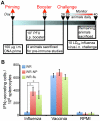A human multi-epitope recombinant vaccinia virus as a universal T cell vaccine candidate against influenza virus
- PMID: 21998725
- PMCID: PMC3187825
- DOI: 10.1371/journal.pone.0025938
A human multi-epitope recombinant vaccinia virus as a universal T cell vaccine candidate against influenza virus
Abstract
There is a need to develop a universal vaccine against influenza virus infection to avoid developing new formulations of a seasonal vaccine each year. Many of the vaccine strategies for a universal vaccine target strain-conserved influenza virus proteins, such as the matrix, polymerase, and nucleoproteins, rather than the surface hemagglutinin and neuraminidase proteins. In addition, non-disease-causing viral vectors are a popular choice as a delivery system for the influenza virus antigens. As a proof-of-concept, we have designed a novel influenza virus immunogen based on the NP backbone containing human T cell epitopes for M1, NS1, NP, PB1 and PA proteins (referred as NPmix) as well as a construct containing the conserved regions of influenza virus neuraminidase (N-terminal) and hemagglutinin (C-terminal) (referred as NA-HA). DNA vectors and vaccinia virus recombinants expressing NPmix (WR-NP) or both NPmix plus NA-HA (WR-flu) in the cytosol were tested in a heterologous DNA-prime/vaccinia virus-boost vaccine regimen in mice. We observed an increase in the number of influenza virus-specific IFNγ-secreting splenocytes, composed of populations marked by CD4(+) and CD8(+) T cells producing IFNγ or TNFα. Upon challenge with influenza virus, the vaccinated mice exhibited decreased viral load in the lungs and a delay in mortality. These findings suggest that DNA prime/poxvirus boost with human multi-epitope recombinant influenza virus proteins is a valid approach for a general T-cell vaccine to protect against influenza virus infection.
Conflict of interest statement
Figures








Similar articles
-
Protective Efficacy of the Conserved NP, PB1, and M1 Proteins as Immunogens in DNA- and Vaccinia Virus-Based Universal Influenza A Virus Vaccines in Mice.Clin Vaccine Immunol. 2015 Jun;22(6):618-30. doi: 10.1128/CVI.00091-15. Epub 2015 Apr 1. Clin Vaccine Immunol. 2015. PMID: 25834017 Free PMC article.
-
Influenza and vaccinia viruses expressing malaria CD8+ T and B cell epitopes. Comparison of their immunogenicity and capacity to induce protective immunity.J Immunol. 1994 Nov 15;153(10):4636-48. J Immunol. 1994. PMID: 7525709
-
Vaccination With Viral Vectors Expressing Chimeric Hemagglutinin, NP and M1 Antigens Protects Ferrets Against Influenza Virus Challenge.Front Immunol. 2019 Aug 21;10:2005. doi: 10.3389/fimmu.2019.02005. eCollection 2019. Front Immunol. 2019. PMID: 31497029 Free PMC article.
-
Progress on adenovirus-vectored universal influenza vaccines.Hum Vaccin Immunother. 2015;11(5):1209-22. doi: 10.1080/21645515.2015.1016674. Hum Vaccin Immunother. 2015. PMID: 25876176 Free PMC article. Review.
-
Virus-specific T cells as correlate of (cross-)protective immunity against influenza.Vaccine. 2015 Jan 15;33(4):500-6. doi: 10.1016/j.vaccine.2014.11.054. Epub 2014 Dec 9. Vaccine. 2015. PMID: 25498210 Review.
Cited by
-
Immuno-Informatics Analysis of Pakistan-Based HCV Subtype-3a for Chimeric Polypeptide Vaccine Design.Vaccines (Basel). 2021 Mar 21;9(3):293. doi: 10.3390/vaccines9030293. Vaccines (Basel). 2021. PMID: 33801143 Free PMC article.
-
Roles for Treg expansion and HMGB1 signaling through the TLR1-2-6 axis in determining the magnitude of the antigen-specific immune response to MVA85A.PLoS One. 2013 Jul 3;8(7):e67922. doi: 10.1371/journal.pone.0067922. Print 2013. PLoS One. 2013. PMID: 23844129 Free PMC article.
-
Universal Vaccines and Vaccine Platforms to Protect against Influenza Viruses in Humans and Agriculture.Front Microbiol. 2018 Feb 6;9:123. doi: 10.3389/fmicb.2018.00123. eCollection 2018. Front Microbiol. 2018. PMID: 29467737 Free PMC article. Review.
-
In Vivo Validation of Predicted and Conserved T Cell Epitopes in a Swine Influenza Model.PLoS One. 2016 Jul 13;11(7):e0159237. doi: 10.1371/journal.pone.0159237. eCollection 2016. PLoS One. 2016. PMID: 27411061 Free PMC article.
-
Multigenic DNA vaccine induces protective cross-reactive T cell responses against heterologous influenza virus in nonhuman primates.PLoS One. 2017 Dec 21;12(12):e0189780. doi: 10.1371/journal.pone.0189780. eCollection 2017. PLoS One. 2017. PMID: 29267331 Free PMC article.
References
-
- Regoes RR, Bonhoeffer S. Emergence of Drug-Resistant Influenza Virus: Population Dynamical Considerations. Science. 2006;312:389–391. - PubMed
-
- Gibbs MJ, Armstrong JS, Gibbs AJ. Recombination in the Hemagglutinin Gene of the 1918 “Spanish Flu”. Science. 2001;293:1842–1845. - PubMed
-
- Li KS, Guan Y, Wang J, Smith GJD, Xu KM, et al. Genesis of a highly pathogenic and potentially pandemic H5N1 influenza virus in eastern Asia. Nature. 2004;430:209–213. - PubMed
-
- Thompson WW, Shay DK, Weintraub E, Brammer L, Bridges CB, et al. Influenza-associated hospitalizations in the United States. JAMA. 2004;292:1333–1340. - PubMed
Publication types
MeSH terms
Substances
LinkOut - more resources
Full Text Sources
Other Literature Sources
Medical
Research Materials
Miscellaneous

